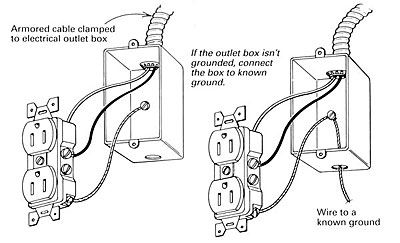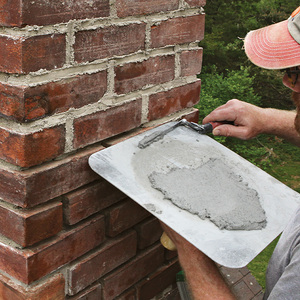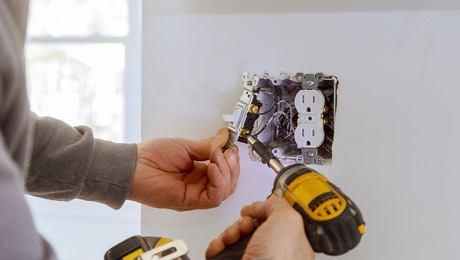Q:
We live in an older house with a retrofitted electrical system. The wires are housed in a flexible conduit, which I’ve learned is called armored cable, or BX. We’d like to convert our old two-prong outlets to three-prong, grounded outlets. Can we do this project without rewiring the entire house?
Terri Gaulkin, Watertown, CT
A:
Tim Luce, a master electrician in South Kingstown, Rhode Island, replies: There are a couple of ways to change your old two-prong, ungrounded receptacles to three-prong, grounded receptacles safely without having to rewire your house. As with any work on existing wiring, the first step is shutting off the power to the circuit that you will be working on. Next, remove the wall cover plate and the old receptacle.
The third prong on a three-prong receptacle is for grounding. In order to function properly, the ground screw on the receptacle must be connected to a known ground, usually to a ground wire running from the main panel. On older homes, the flexible metal conduit on armored cable is normally used in place of a ground wire. The conduit is clamped to the electrical outlet box on one end and to a known ground, such as the grounding stake on the other end (at the main panel). The electrical outlet box then can act as a ground for the receptacle.
It’s best to test the outlet box to make sure it’s properly grounded before you connect a ground wire to it. You can do this with a continuity tester, checking the continuity between the box and a known ground. If testing shows that the box is properly grounded, insert a 10/32 machine screw into the hole in the back of the box and attach the ground wire from the grounding screw on the new receptacle here. The hot and neutral wires then can be attached to their proper terminals and the new receptacle screwed into the electrical outlet box.
After you’ve finished the installation of the new outlet, I recommend testing the outlet with a three-light tester (see Ground-Fault Protection) to confirm that the outlet is functioning properly. In most cases, this work is all you’ll need to do to replace your receptacles.
In my experience, if an outlet box is not grounded, it’s usually due to corrosion that has broken the connection or rusted out the metal conduit at some point between the box and the main panel. Finding that point may be next to impossible, and an alternative is running a ground wire from the grounding screw on the outlet box back to known ground.
By the way, you shouldn’t assume that the copper water pipe in your house is a good grounding point. Because of the wide use of plastic piping for the water-supply line into a house, the national code no longer allows the connection of a ground wire to a metal water pipe unless it’s within 5 ft. of where a metal supply pipe enters the house. Connecting the grounding wire to the grounding stake at the main electrical panel is the safest bet if you choose to travel this route, but this installation procedure is probably best undertaken by a licensed electrician.
Another replacement solution can be found in a special exception granted by the National Electric Code in section 210-7D of the 1993 codebook. As strange as it may seem, the code recommends replacing a two-prong receptacle with a ground fault circuit interrupter (GFCI) without attaching a wire to the GFCI’s grounding screw. Any receptacles downstream of the GFCI, hooked up to the load side of the GFCI, should be replaced with a standard three-prong outlets, but again with no wire attached to the grounding screw. This system works because the GFCI monitors the difference in current between the black and the white wires and does not depend on a ground wire to protect the circuit.
The biggest problem with this solution is determining exactly which outlets or other circuits might be shared by the GFCI-protected circuit. Electrical installations in older homes were often done using the easiest path for snaking wires through walls and ceilings, and sometimes they don’t follow logical patterns. A further complication to this method of receptacle replacement is that the downstream receptacles will test as ungrounded even though they are protected by the GFCI. Because of these complications, I would again recommend having a licensed electrician do the work. It’s also a good idea to check with your local electrical inspector to make sure that there are no exceptions in the local code that prohibit these types of installations.


























